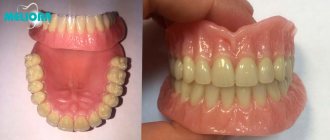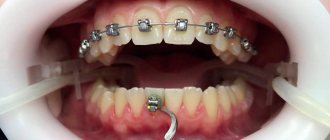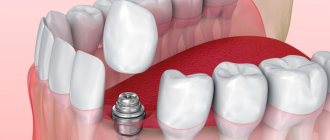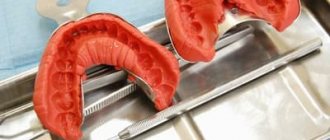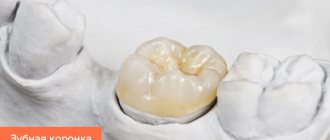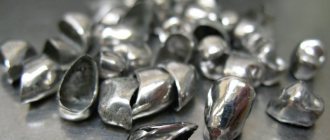A crown is the name in dentistry for a prosthesis that is placed on a tooth, on an implanted implant, or included in the structure of a dental bridge. With the help of dental crowns, you can restore severely damaged or lost teeth, the restoration of which must be carried out urgently and for this you must contact a dentist.
How the crown will be installed, whether it hurts to put a crown on a tooth - we will answer all these questions in detail in our article.
When is it necessary to put a crown on a tooth: indications for restoring teeth with a crown
The need to place a crown on a tooth may arise in the following situations:
- The tooth is severely damaged by caries. If the natural crown of a tooth is damaged by more than 50% by caries, then it would be more correct to put a crown on the tooth rather than restore it with a filling. Large fillings do not withstand the chewing load well and may fall out or break, and the tooth may break along with the filling. If the root of the tooth is damaged, then it will have to be removed. By placing a crown on a decayed tooth, you have the opportunity to save it;
- The tooth is destroyed as a result of trauma. If the roots of a tooth were not affected by injury, it is possible to restore the tooth - it will be enough to put a crown on it;
- You can also put a crown on a tooth for aesthetic restoration: for example, if a tooth is chipped or its enamel has changed color, becoming gray or yellow, and this defect cannot be eliminated by classic whitening.
Doctors recommend placing temporary crowns to preserve teeth for patients with periodontitis. In this case, crowns prevent teeth from becoming loose and falling out.
In your case, do you need to put a crown on your tooth or is it possible to use another restoration method? The doctors of our dental clinic in Moscow, “Firadent,” can help you find the answer to this question. To make an appointment with our specialists, you just need to dial our dental clinic’s phone number!
What are metal-ceramic dental crowns and bridges made of?
The crown consists of 2 parts – the frame and the covering.
If the crown is metal-ceramic, then the frame is made of metal . In the Health Clinic Istok is a special alloy made in Germany - GIALLOY . The frame is covered with ceramic mass , which is baked in an oven at 400C. The color of the ceramic mass is selected by the doctor in accordance with the color of your teeth or at the request of the patient. The Istok Health Clinic uses ceramics from well-known manufacturers Noritake, Ivoclar, Duceram Plus, e-max Ceram
I need to put a crown on a tooth: is the treatment painful?
Statistics show that most people, knowing that they need to put a crown on a tooth, still postpone their treatment for fear of visiting the dentist and the pain that supposedly cannot be avoided with dental prosthetics. Does it really hurt to put a crown on a tooth? Let's look at this issue together.
So is it painful to put a crown on a tooth or not? The most painful stage in the process of installing a crown on a tooth will be the preparation, during which the teeth are treated for caries, depulped (if necessary), and also ground down to the thickness of the future crown. All these procedures are not performed without anesthesia, as they can cause quite severe pain to the person.
Before you begin to treat and prepare the tooth for placing a crown on it, the doctor will definitely perform an anesthesia procedure using a local anesthetic. The type and amount of the drug are selected individually for each patient. The use of anesthesia makes the process of preparing the tooth for crown installation painless.
If the patient experiences a literally panicky fear of dentists, in our dental clinic “Firadent” he may be offered dental treatment in his sleep[/anchor], under sedation. Sedation should not be confused with general anesthesia; it is a light medicated sleep in which the patient will remain during treatment. Sedation allows you to relieve the patient not only from pain when preparing teeth for prosthetics, but also from psychological discomfort and stress! Moreover, after sedation there are no negative side effects, which are not uncommon after general anesthesia.
You can read all the details on dental treatment during sleep in a separate article on our website, which is devoted to sedation, or find out during a consultation with the doctors of our clinic - “Firadent”.
How much does it cost to fix a stump tab?
The price of a stump inlay in Moscow depends on the material of manufacture, its size, type and number of pins. A single-root stump inlay made of chromium and cobalt alloy will cost from 2,000 rubles. And when a tooth has several roots, the cost of a cast stump inlay for a metal tooth can increase to 5,000 rubles. The price of a stump pin insert made of composite is approximately 6,000 rubles, and of ceramics - about 12,000 rubles. The cost of zirconium core inlays starts from 15,000 rubles. If we are talking about a collapsible design, then the price of a stump inlay for a crown will be slightly higher than that of a solid-cast stump inlay.
Initial examination and diagnosis
The decision that a crown needs to be placed on a tooth is made by an orthopedic dentist after examining the patient’s oral cavity and teeth, as well as performing a number of diagnostic measures. Based on the data obtained, the orthopedist will develop a treatment plan, which may include not only the installation procedure itself, but also a number of additional measures:
- Professional oral hygiene, which allows you to clean your teeth from plaque and tartar;
- Removal of severely damaged teeth that cannot be properly treated and restored with a filling;
- Treatment of caries and any other diseases of the teeth and gums diagnosed during examination;
- Tooth removal, treatment and filling of canals.
Note that depulping a tooth before placing a crown on it is not always done. The depulpation procedure involves removing the dental nerve, after which the tooth becomes more fragile and vulnerable to external factors. If a tooth has more than one root and is in good condition, doctors prefer not to remove the dental nerve and put a crown on a living tooth.
When drawing up a treatment plan, the question of what kind of crown will be placed on the tooth is also decided. Modern dental crowns are made from different materials and there is always the opportunity to choose the version of the prosthesis that will most suit the patient in terms of aesthetics, price and durability.
The drawn up treatment plan is agreed with the patient and after agreement the treatment process begins. The first step is to prepare the tooth for the installation of a crown.
Does it hurt to put it on?
Prosthetics is an uncomfortable and traumatic process. There is nothing terrible about it, but at certain stages painful sensations are possible:
- Preparation. If a living tooth needs to be treated for caries, pulpitis and other inflammatory processes, it is anesthetized. It is not necessary to administer anesthesia before endodontic treatment of dead units.
- Stitching and ledge formation. Vital teeth are prepared under anesthesia. Depulped ones are ground down to a living one, but because... Damage to the gums is possible; at the patient’s request, a superficial injection is given.
- Retraction. It is carried out during the formation of the ledge and before taking impressions. The placement of the thread is accompanied by a slight separation of the soft tissues from the tooth and the formation of gingival grooves. This is a painful procedure, so anesthesia is required.
- Taking impressions. It doesn't hurt, you only feel pressure on the jaw. But vital units can react sharply; in such cases, anesthesia is given. Nausea is also possible in patients with an increased gag reflex. Such patients are recommended to start taking mild sedatives – valerian, motherwort – a few days before going to the clinic. And immediately before applying the impression mass, the doctor sprays the root of the tongue with lidocaine spray.
- Cleaning the interdental areas from the remains of the impression mass. It is removed with dental floss and thin metal plates. During this, pressure and bursting are felt, and the gingival papillae may be injured. But overall the manipulation is tolerable.
- Fitting and fixation. They are painless and are accompanied by only slight pressure on the jaw.
Stages of prosthetics
In general, installing a crown on a tooth is more uncomfortable than painful. Report any sudden unpleasant sensations to the doctor - he will immediately administer anesthesia.
Preparing to install a dental crown
Preparing for a dental crown may include the following procedures:
- Professional teeth cleaning. Removing tartar and plaque from the surfaces of teeth will help you accurately select the color of the future crown, as well as identify primary caries and other diseases that are important to cure before placing a crown on the tooth.
- Treatment of caries, pulpitis, periodontitis, and gum inflammation. You can’t put a crown on sick teeth!
- Treatment of the tooth on which a crown will be placed. During this process, the doctor will drill out the tooth and remove all tissue affected by caries. If necessary, tooth depulpation is carried out, as well as treatment and filling of dental canals.
IMPORTANT: Dental canal treatment must be of high quality! If during the treatment of the canals the doctor makes a mistake, does not remove all the tissues affected by inflammation, or fills the canals incorrectly, the tooth may begin to hurt already under the crown, and then it will have to be removed and treated again! In our dental clinic “Firadent” in Moscow, treatment of tooth canals is carried out under a microscope with an optical device, which allows the doctor not to act at random, but to accurately see the length and internal space of the dental canals, and therefore carry out the procedure with impeccable quality.
After filling the canals, the tooth is restored with a filling and the next stage in prosthetics begins - turning the tooth under a crown.
Installation of the stump tab
Before prosthetics with stump inlays, it is necessary to remove the nerve and carry out endodontic treatment of the canals in order to eliminate their inflammation and seal them properly. After this, the tooth is prepared for an inlay, the canals are unfilled to 1/3 or 2/3 of their length, they are made wider and given a conical shape, and then procedures typical for the direct or indirect method of manufacturing a microprosthesis are carried out.
Stages of installing the stump tab
- All teeth are disinfected with alcohol and dried.
- The stump tab is degreased and covered with cement along with the pins.
- The holes in the channels are filled with a solution, and a microprosthesis is installed in them.
- For final fixation of the stump tab, the doctor applies strong pressure on it.
After this, all that remains is to take impressions from the stump insert installed in the tooth to make a crown from the material chosen by the patient.
Grinding a tooth for a crown
Before placing a crown on a tooth, the tooth must be ground to the thickness of the future prosthesis. This procedure in professional dentistry is called “preparation”. The enamel of the tooth is ground down with a drill and during the treatment the doctor will give the tooth a shape that will allow the crown to be placed firmly and tightly.
IMPORTANT: Grinding of live teeth can be quite painful, so local anesthesia must be administered before performing this procedure. If the tooth was depulped before grinding, local anesthesia may not be used, the procedure will not cause pain.
When preparing teeth, a layer of tissue is removed from the tooth before placing a crown. The thickness of the layer will depend on how thick the crown will be. A minimal layer of tissue is removed from the teeth for cast crowns; a significant layer of tissue must be removed from the tooth if it is decided to install ceramic or metal-ceramic crowns. On average, during the grinding process, about 2.5 mm of tissue is removed from a tooth on each side.
As a result of tooth preparation, a core base (stump) is obtained, on which the doctor will place a crown.
Is implantation possible after tooth root removal?
Yes, of course it is possible. And we at the clinics of the German Implantology Center widely use implantation after tooth root removal. Our conditions allow us to carry out implantation in such cases. And if we can achieve primary stability of the implant, then in 90% of cases
After removal, we immediately install the implant. We have rolled out the technology to perfection and gives excellent results.
Of course, with the exception of wisdom teeth, no implant is placed after their removal. But, by the way, wisdom teeth in this situation can be extremely useful, since they... can be transplanted to the place of the problem tooth being removed! Dental transplantation has been practiced in the clinics of the German Implantology Center since 2017, and our specialists have accumulated a wealth of clinical experience. Let's talk about this a little more.
Making crowns
Crowns are made from an impression that is taken from the prepared teeth. To obtain this impression, the orthodontist will use a special plastic mass. Based on the impression taken, the laboratory will first make a plaster model of the prosthesis, and then a crown, which will be placed on the tooth.
Modern dental crowns are made from different materials: metal, ceramic, metal-ceramic and zirconium. The timing of the production of the prosthesis will depend on what kind of crown it is decided to place on the tooth. Crowns made of ceramics and metal-ceramics take the longest to produce. So that a person does not have to walk without a tooth during the entire time of making the crowns, a temporary plastic prosthesis is put on the tooth.
IMPORTANT: Temporary plastic crowns help hide a defect in the dentition; a person will not have to be embarrassed by the absence of a tooth and experience stress for this reason. Also, temporary dentures help protect a ground and therefore weakened tooth from the negative effects of environmental factors and bacteria.
Making a dental crown in a dental laboratory.
After completing the medical stages, a fighter on the invisible front for the patient—the dental technician—comes into action. The resulting impressions are sent to the dental laboratory, where the actual production of the crown itself takes place. Schematically it looks like this:
— an impression technician casts a plaster model
— the frame of the future crown is modeled from wax on the treated tooth
— the wax frame is melted into metal (in the case of making a metal-ceramic crown) or transferred to a zirconium dioxide/lithium disilicate frame to make a metal-free crown (more on this in part two)
— then the technician applies layer-by-layer ceramic mass to the frame, which initially looks like thick sour cream, and after baking in a special oven takes on a “human” appearance. At the same time, the technician tries to the best of his ability to give the crown the desired anatomical shape and the desired color.
Try-on, temporary and permanent fixation of the crown
Before placing a crown on a tooth, it must be tried on. For this purpose, the patient is invited to the clinic. During the fitting, the accuracy of the crown's manufacturing and the tightness of its fit on the stump base are assessed. If the fitting does not reveal manufacturing inaccuracies, the patient does not feel discomfort and is satisfied with the aesthetics of the finished product - a temporary fixation of the crown is performed on the tooth.
What is temporary fixation? This is a kind of “test drive” of the crown. With a crown placed on a temporary basis, the patient will walk for a certain period of time (usually up to 4 weeks). If during this time no defects or inaccuracies are identified in the manufacture of the crowns, the patient comes to the clinic and the crown is placed and fixed with permanent dental cement.
At this point, the crown installation process can be considered complete.
Two methods of prosthetics for front teeth for caries:
1. The crown on the front teeth is attached to a pin
– a miniature screw rod is screwed into the sealed root canal. Filling material is applied to its upper part, ground to the required size, and a crown is installed. But again, pins are gradually being replaced by the more patient-friendly CEREC technology. And patients come to me with problems with previously installed pins with the goal of replacing them with a single dental module, as in the following video:
2. Crown on the front tooth using a stump inlay
– this element is made in the laboratory. Outwardly, it resembles a tooth stump. It is securely attached to the root canal and the prosthesis is securely fixed on its upper part (stump). But, despite its popularity, the stump inlay has one significant drawback - it forms an additional adhesive connection both with the tooth tissue and with the crown being installed. This can be avoided by restoring the front teeth using CEREC technology. When using Cerec technology and using “root + crown” type modules, we reduce the gluing points to just one:
Installation of dentures using “root + crown” modules on the front teeth increases the service life of the crowns. In addition, they allow you to create the ideal tooth shape, which is important when replacing teeth in the smile area.
How to place a crown on an implant?
A crown can be placed not only on a tooth, but also on an implant. This allows you to restore lost teeth without grinding down healthy units in the rows. Crowns on implants are durable, aesthetic, and visually indistinguishable from natural teeth.
Before placing a crown on an implant, an artificial root implantation procedure is performed. As soon as the implant takes root, an abutment is placed on it, and then a crown. Putting a crown on an implant will be more expensive than conventional prosthetics, but the price of the service is fully compensated by the impeccable aesthetics and long service life of both the implant and the crown.
Crown service life
Patients who plan to get a crown are often interested in its useful lifespan. The service life of a crown placed on a tooth will depend on a number of factors:
- Crown material and technology;
- The patient’s compliance with all doctor’s recommendations for crown care;
- Quality of preparation of teeth for prosthetics.
The last factor is of fundamental importance: if mistakes are made during the preparation and manufacturing of the crown, the crown will not last long, and undesirable complications may arise, due to which the crown will have to be removed and re-installed on the tooth. For these reasons, you need to very carefully choose the clinic where you plan to treat and restore your teeth! Remember that the worst type of saving is saving on your own health!
The crown must be placed in a well-equipped dental clinic, staffed by experienced orthopedic doctors and dental technicians. The clinic must use the most modern technologies for diagnostics, treatment and dental prosthetics; only this approach to the choice of dentistry guarantees high quality treatment!
What the patient needs to understand before root removal
You need to assess the health risks, you need to talk to the attending surgeon, find out about his experience. Quite often, tooth root removal is carried out, unfortunately, with the following negative consequences:
- gums are torn
- fractured bony vestibular plate
Sometimes when visiting such patients, you get the feeling that the tooth was not removed, but knocked out with something. There were cases when a patient’s extraction began in some clinic, and there, in the middle of the patient’s appointment, the doctor announced that he was unable to remove it, and the patients came to us in this form to remove the root of a tooth that was already in the extraction stage.
When removing the roots of wisdom teeth, you may face risks such as jaw fracture. One of the common risks of removing the roots of 3 molars is damage to the mandibular nerve
, leading to cuts and numbness in areas of the jaw. There is a risk of damaging the artery on the lingual side.
If, when a tooth is removed, a root or part of it is left behind, what should you do?
According to Russian treatment standards, the tooth root cannot be left during extraction. That is, if the patient was left with a root or part of it during removal, then this is considered a poorly performed surgical procedure.
In European countries there are doctors who agree that if there is no inflammation on the tooth and if the root part is not infected, and removal of the root leads to trauma, then only the cortical part of the root is removed, and the other part remains in the bone.
If the patient is left with a part of the root that is infected, then this is a problem. A cyst may develop and inflammation may develop. If the apical part was not infected, then everything heals and does not bring any trouble to the patient.
Tooth root without crown part
Can a tooth root without a crown cause inflammation in the gums or bone? Of course it can. There is a canal at the root of the tooth; if this canal is infected, then the problem will develop into a negative prognosis.
Inflammation, suppuration, periostitis, osteomyelitis - diseases can develop due to an infected tooth root. And the source of infection at the root must be removed; if it is impossible to remove the infection and preserve the root, then it must be removed.
How much does it cost to put a crown on a tooth?
How much does it cost to put a crown on a tooth? It is difficult to give a definite and precise answer to this question, because the cost of installing a crown may include various additional but necessary procedures. For example, professional teeth cleaning, treatment of caries or pulpitis, treatment and filling of canals.
The cost of installing a crown will be influenced by both the material and the production technology of the prosthesis. The most expensive options are ceramic and zirconium crowns produced using CAD/CAM technology. But such crowns fully pay for their cost due to their high strength, reliability and aesthetics.
Also, the cost of installing a crown will depend on how it will be placed - on an abutment tooth or on an implant.
The best way to find out how much it costs to put a crown on a tooth is to come to an appointment with orthopedic doctors at our dental clinic in Moscow - “Firadent”. Experienced specialists of our dentistry will conduct an examination and diagnosis and draw up a treatment plan, which will indicate the exact price of the service.
Installation cost
Prices for installing crowns vary greatly. The variation is due to the materials of the prostheses, their quality, the pricing policy of clinics and the skill of the doctor. In Moscow the cost is as follows:
- temporary plastic: minimum 800 rubles, maximum 7,500 rubles, average – 1,500 rubles;
- metal: for alloys of cobalt with chromium or nickel 1,500-4,000 rubles, the price of a titanium structure reaches 20,000 rubles, gold products will cost 10-15 thousand rubles.
- metal-ceramic: minimum 5,000 rubles, on average – 10-12 thousand rubles;
- metal-ceramic of improved aesthetics with shoulder mass: 12-16 thousand rubles;
- all-ceramic: from 12,000 rubles, on average – 25,000 rubles, in some clinics the cost reaches 50-70 thousand rubles;
- zirconium: minimum 15,000 rubles, on average – 25-30 thousand rubles, in a number of dentists the price of the service reaches 40-55 thousand rubles.
Some dentists include in their price list turnkey prices for the preparation, production and installation of crowns. The latter indicate only the cost of the prosthesis itself. And preliminary treatment is always calculated separately for each patient.


